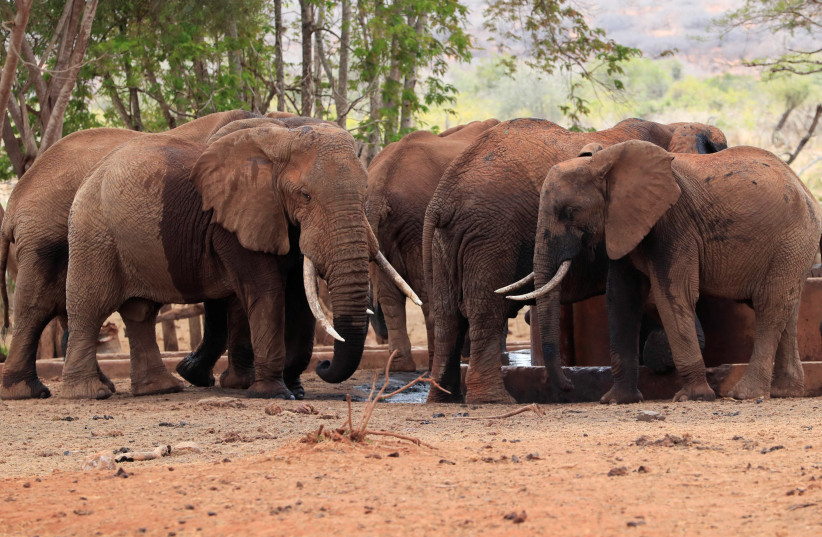Elephants play a key role in creating forests that store atmospheric carbon and maintain biodiversity in Africa, according to research at Saint Louis University and the Laboratory of Climate and Environmental Sciences (LSCE) in France.
The findings were published in Proceedings of the [US] National Academy of Sciences under the title “Megaherbivores modify forest structure and increase carbon stocks through multiple pathways.” The team was led by biology Prof. Stephen Blake in Missouri and doctoral student Fabio Berzaghi at LSCE.
In the article, they warn that if already critically endangered elephants become extinct, rain forest of Central and West Africa – the second largest rainforest on Earth – would lose between 6% and 9% of their ability to capture atmospheric carbon, boosting global warming.
Herbivores weighing about 1,000 kgs. (2,200 lbs) – also known as megaherbivores – can significantly influence the structure and functioning of ecosystems, they wrote.
“Elephants have been hunted by humans for millennia,” Blake said. “As a result, African forest elephants are critically endangered. The argument that everybody loves elephants hasn’t raised sufficient support to stop the killing. Shifting the argument for elephant conservation toward the role forest elephants play in maintaining the biodiversity of the forest, that losing elephants would mean losing forest biodiversity, hasn’t worked either, as numbers continue to fall.”

Environmental impacts of the elephant's diet
Elephants and other megaherbivores affect the abundance of these trees by feeding more heavily on the low-carbon-density trees, which are more palatable and nutritious than the other types. This “thins” the forest, much like a forester would do to promote growth of preferred species. Thinning reduces competition among trees and provides more light, space and soil nutrients to help the high-carbon trees to flourish.
“ELEPHANTS EAT lots of leaves from lots of trees, and they do a lot of damage when they eat,” Blake said. “They’ll strip leaves from trees, rip off a whole branch or uproot a sapling when eating, and our data show most of this damage occurs to low-carbon-density trees. If there are a lot of high-carbon-density trees around, that’s one less competitor eliminated by the elephants.”
Elephants are also excellent dispersers of the seeds of high-carbon-density trees that often produce large nutritious fruits that elephants eat. Those seeds pass through the elephants’ gut undamaged, and when released through dung, they are primed to germinate and grow into some of the largest trees in the forest.
“Elephants are the gardeners of the forest,” Blake said. “They plant the forest with high-carbon-density trees and get rid of the ‘weeds,’ which are the low-carbon-density trees. They do a tremendous amount of work maintaining the diversity of the forest.”
Due to these preferences, elephants are directly tied to influencing carbon levels in the atmosphere. High-carbon-density trees store more carbon from the atmosphere in their wood than low-carbon-density trees, helping combat global warming.
Research team member Berzaghi is now looking ahead to the future to determine how other animals in the rain forests affect its biodiversity and if they have the same impact as elephants.
“The implications of our study extend beyond just forest elephants in Africa,” he said. “As we show that leaves from low-carbon-density trees are less palatable to herbivores, those findings imply that other large herbivores such as primates or the Asian elephant could also contribute to the growth of high-carbon-density trees in other tropical forests. Our aim is to expand on this by investigating those other species and regions.”
So, the arguments to conserve the forest elephants of the Congo Basin and West Africa have never been greater. Populations of elephants have been eliminated from many areas of the forest, and in many areas they are functionally extinct, meaning their populations are so low that they have no significant impact on the ecology of the forest. Blake is calling for more protection for forest elephants.
“The illegal killing of elephants and the illegal trade remains active,” Blake concluded. “Ten million elephants once roamed across Africa, and now there are less than 500,000, with most populations living in isolated pockets. These elephants range from endangered to critically endangered, with their numbers plummeting by more than 80% in the last 30-plus years.
“Elephants are protected under national and international law, and yet poaching continues. These illegal killings must stop to prevent forest elephant extinction. Now we have a choice. As a global society, we can continue to hunt these highly social and intelligent animals and watch them become extinct, or we can find ways to stop this illegal activity. Save the elephants and help save the planet. It really is that simple.”
